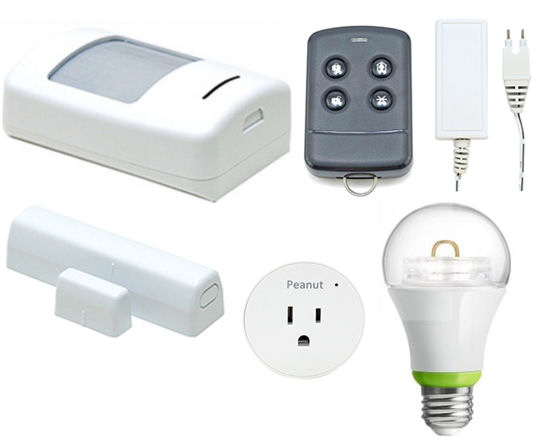
| At a Glance | |
|---|---|
| Product | Securifi Almond + Home Automation [Website] |
| Summary | Wireless router easily connects to ZigBee H.A. devices, but what you can do with them is a work in progress |
| Pros | • ZigBee devices are very easy to link to network • ZigBee/Z-Wave devices are added via the touch screen interface • Android/iOS apps • Wide range of available ZigBee/Z-Wave compatible devices |
| Cons | • No instruction manual • HA features require internet connection • Notifications are only available via in-app notification – no email/text options • Notifications currently only work on Android platform – iOS support planned • No support for IFTTT |
Introduction
Several weeks ago I reviewed the Securifi Almond+ router. In addition to having a color touch screen interface, the Almond+ features include both ZigBee and Z-Wave radios. With support of these two popular Home Automation wireless connection methods, the Almond+ can function as an all-in-one Smart Home hub supporting both data networking and home automation control
While the original Almond+ review primarily covered basic router functions, this follow-up review focuses on the Almond+’ Home Automation features. I’ll be looking at how the router works with (image above, clockwise from lower right) GE’s Link Smart LED bulb ($15) and Securifi’s Peanut Plug (not sold separately), Window/Door sensor ($25), PIR Motion sensor ($30), Key Fob ($15) and flood sensor ($25).
Securifi provides a fairly extensive list of compatible sensors that work with the Almond+. Supported devices include LED light bulbs, tilt, motion and vibration sensors, door locks from Yale, Schlage, Vision and Kwikset and thermostats from Trane, Lowes (Iris) and others. Other ZigBee and Z-Wave products not included in the list may also work with the Almond+ if they properly support ZigBee and Z-Wave protocols. The Securifi Wiki also has a list of sensors that don’t work with the Almond+.
Hands On
I’ll preface this section by noting that all HA features require a working internet connection. To test this, I connected my iPad to the Wi-Fi network on the Almond + router. I was able to turn the GE bulb on and off, energize and de-energize the Peanut Plug and check sensor status. I then disconnected the internet connection from the Almond+ router and could no longer control devices or read sensor status.
Setting up Home Automation devices is simple and the same for almost all devices I tested. For battery powered devices, in most cases you’ll have to remove the cover from the device and install a battery. Generally, on the inside of the case you’ll find a link button as well as an LED. To link the sensor, you just depress the link button for about 1 second, then tap the “Add Device” icon on the screen of the Almond+. The Almond+ will find the device, read its configuration and link to it. The touch screen confirms the link and gives you an opportunity to rename the sensor and its location.

Securifi Almond+ Add Sensor and Confirmation
If the sensor fails to link, it may have been previously linked to another device. If so, just press and hold the link button for about 10 seconds to return the sensor to factory defaults.
After adding a device, the status screen will update to show the total number of connected ZigBee and Z-Wave devices. The status screen below shows I have six ZigBee devices linked.
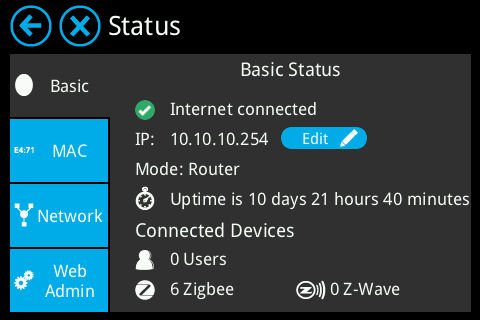
Securifi Almond+ Status
For the devices included in this review, only the Peanut Plug and GE bulb are controllable; the others are read-only sensors. By clicking on the “…” icon, you reveal any configurable options including renaming the sensor and the sensor location.
The user interfaces for controlling the devices is a little convoluted. Not all functions can be performed using either the web UI or the mobile apps, i.e. each UI can do things the other can’t do. From both the Web UI and the mobile app UI, you can control devices and view sensor status.
On the Web UI, this is done under the Sensors tab. The screenshot below shows six linked devices using the web UI. GE bulb #1 shows the expanded option of setting the light level. One nice feature is when you change the status of a controllable device, the web UI shows the latency. Turning on or off either the Peanut Plug or the GE bulb reported latencies obetween 250 ms and 400 ms.
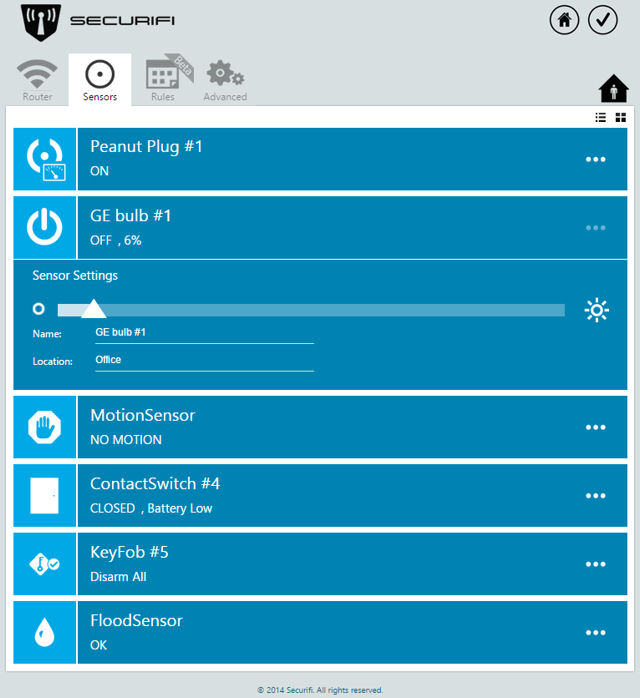
Securifi Almond Plus Web UI showing linked sensors
The browser interface is the only place where you can create rules and you can only do that connected to the router’s LAN. If you attempt to create or modify rules remotely through your Securifi account at connect.securifi.com, you’ll be informed the feature isn’t available.
Creating Securifi rules is much like rule creation on IFTTT. You select a condition that must be met and then you select an action. The composite screenshot below shows the “If” selection criteria on the left and the “Then” actions on the right. Notice that in addition to time and day of week, the conditions for all sensors can be triggers. However, “Home/Away” is not a trigger condition.
You can select multiple trigger conditions, but all of them have to be satisfied for the rule to be executed. You could think of this as rules being “AND” rather than “OR”. For this rule, I selected “Contact Switch Closed” as the condition. For actions, you can only choose controllable devices. In our test scenario, that’s either the Peanut Plug or the GE Light. I elected to flash the GE light at 50% brightness three times in one second increments.
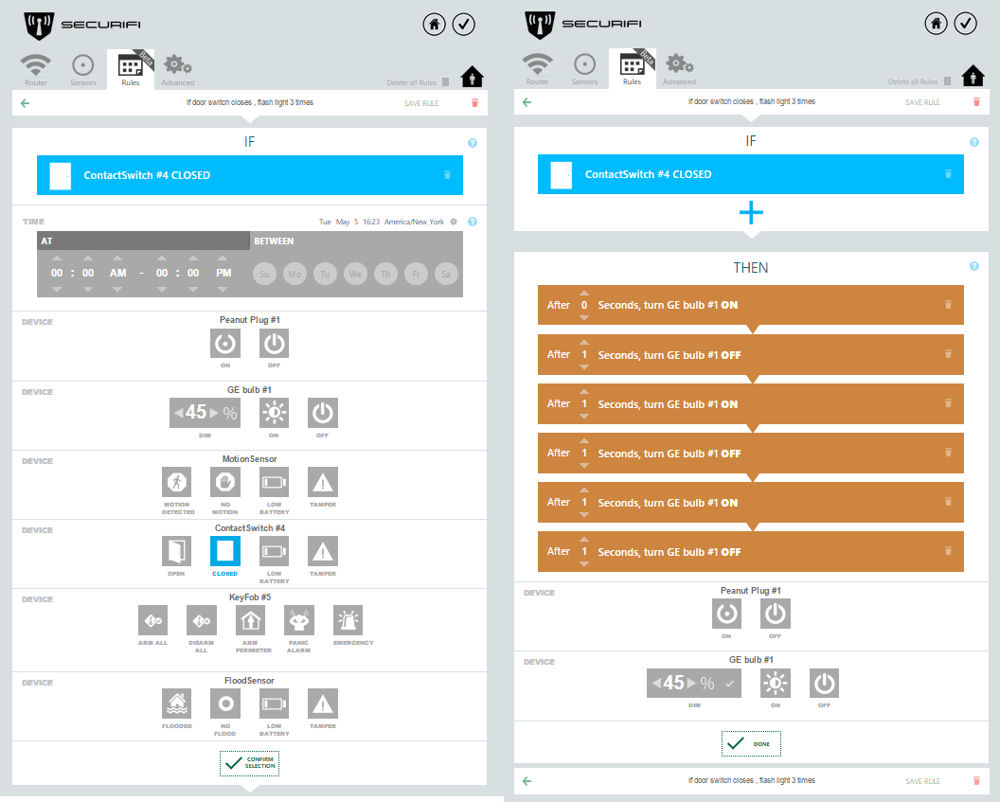
Securifi Almond+ Rule Creation
I created a similar rule to flash the light four times when the door switch changes to “Open”. I also created one other rule to turn on the GE light at 8:00 A.M. and off at 6:00 P.M. on weekdays. Each rule can be edited and can be switched between active and inactive modes. All rules executed exactly as expected.
However, I observed one “flaky” action. With the “door switch open” rule active, I discovered that if I clicked on the home/away icon, the door switch open rule would execute and flash the light four times. If I disabled the rule, clicking on home/away didn’t cause the lights to flash. The door switch closed rule didn’t execute when the home/away icon was clicked. Here’s the summary page for my current rules.
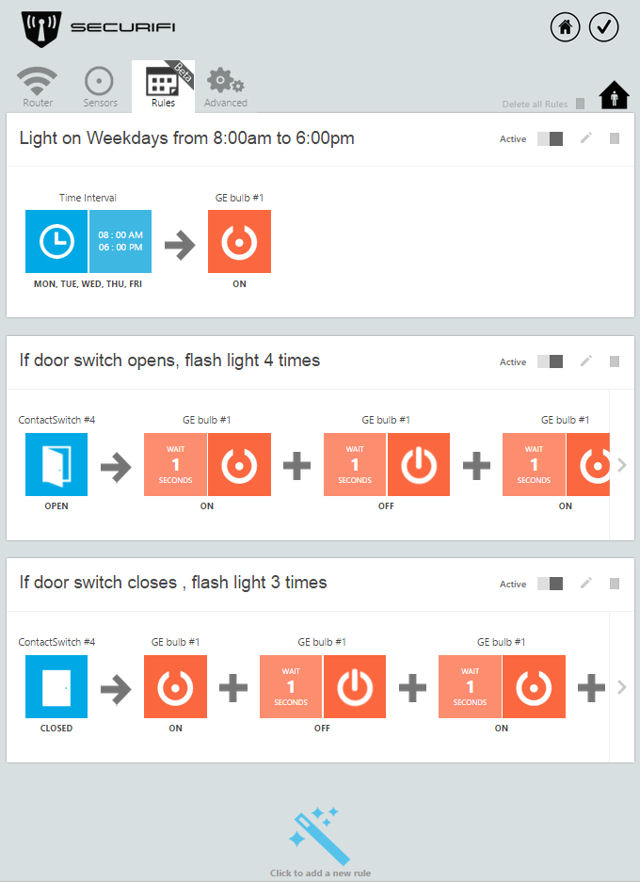
Securifi Almond+ Rule List
Action items, as noted, are limited to controllable devices. You can’t, for example, send a text or email message based on a change in status of one of the sensors. If Securifi supported IFTTT, you could create some rules for email or text notification. Notification are currently limited to in app notifications, and are currently only available on the Android platform. In-app notifications for iOS is currently in development. Here’s a screen shot example of the notification log from my Nexus 7.
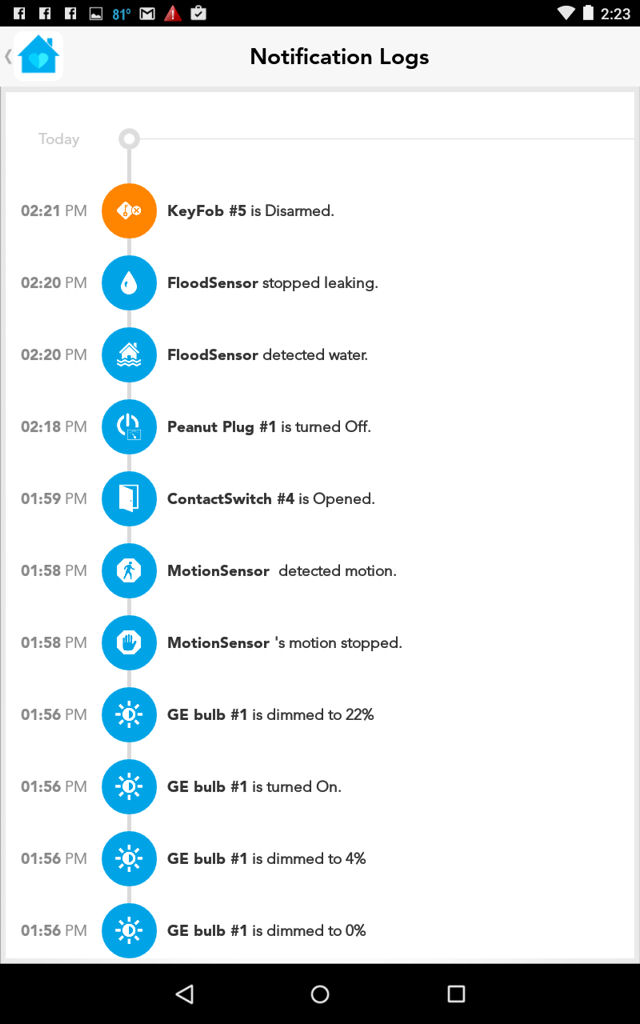
Securifi Almond+ Android Notification Log
Currently, the rule creation feature is still marked beta even though the Almond+ has been on the market since sometime in 2014. I’m wondering if the Rules feature is going to have a similarly long beta cycle as the “Time” and “Weather” beta features that were introduced with the original Almond in 2013. The icons for Time and Weather are still marked “Beta” in the Almond+.
Sensors
I’ll now briefly discuss each of the installed sensors. The gallery below the descriptions shows an expanded view of the options available for each of the sensors.
Peanut Plug – This smart switch is included with the purchase of the Almond+. It’s a ZigBee controlled on/off switch, ideal for learning about the home automation system. Since it is plugged in, it doesn’t need a battery. The link button as well as a manual On/Off button are on the side of the unit. The Peanut Plug is supposed to show Power, Voltage and Current, but I never saw those numbers budge off of zero – even with a load applied. Perhaps that’s a future feature for the plug.
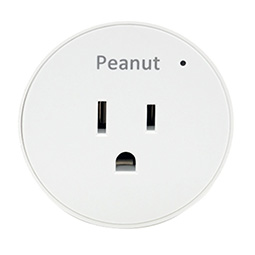
Securifi Peanut Plug
GE Link Bulb – The GE Link bulb is a ZigBee compliant bulb. I reviewed this bulb in our Smart LED Light Bulb Kit review where it was linked to the GE Link hub. Since it was connected to another ZigBee device, I had to reset it to factory defaults. You do that by turning it off for 3 seconds, then on for three seconds. Repeat this on and off sequence three or four times until the light dims automatically and then comes on to full brightness. The light is now ready to pair with the Almond+.
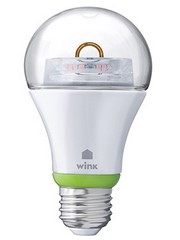
GE Link LED bulb
Though I learned this when I was working with the GE Link bulbs for the previous review, Securifi has a Wiki entry that also covers resetting the GE-Link bulb. To add the GE Link bulb, just go to the Add Sensor button on the Almond+’s touch screen, tap add, and if the bulb is close enough to the Almond+, it will be discovered. After pairing, I had no issues controlling the bulb using either the Web UI or the Android app.
Motion Sensor (SZ-PIR02) – The Motion Sensor is PIR (Passive Infrared) and comes with a wall mounting bracket that tilts the sensor forward to look down on the area being covered. It ships with a CR123A 3VDC 1400 mAh battery that has an expected life of two years. The link button is located inside the device. There is also a spring-loaded tamper switch that will trip when the case is opened and send a notification.
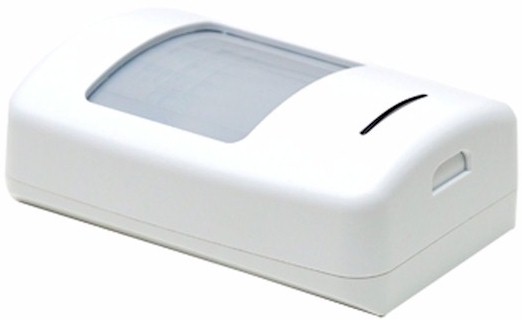
Securifi Motion Sensor
On to , there are two small recessed screws. One adjusts the sensitivity of the unit; the other sets the delay time. The delay time ranges from 5 seconds to 3 minutes. If you set the delay time too short, you will be getting constant notifications of what is probably the same motion event.
Window/Door Sensor (SZ-DWS02) – This is a simple, two part magnetic switch. The sensor attaches to the door near the opening edge using either a supplied mounting bracket or double-sided adhesive tape. The magnet portion mounts to the door jam, also with a bracket or double-sided tape. There are lines molded into the sensor and the magnet to help align them.
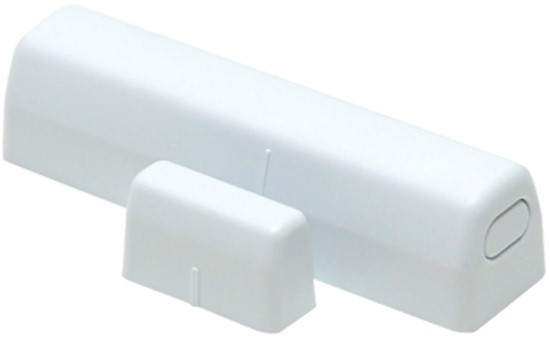
Securifi Window/Door Sensor
The sensor also uses a CR123A battery and has an expected life of 3-4 years. Like the motion sensor, there is a spring-loaded tamper switch that sends a notification when tripped.
Key Fob (SZ-KFB01) – The key fob has four buttons: Arm All; Disarm All, Arm Perimeter; and Reserved. It uses a single CR2032 button battery with an expected battery life of 2 years. I wasn’t sure how to use the fob with any of the installed devices I had. Its Wiki entry has instructions on pairing and resetting the fob and also says: "Currently the key fob works with the rules as a remote, not a key fob, but we’re working on adding support to control the home/away modes with the key fob.". The instruction sheet included with the fob also contains instructions on pairing nad resetting it.
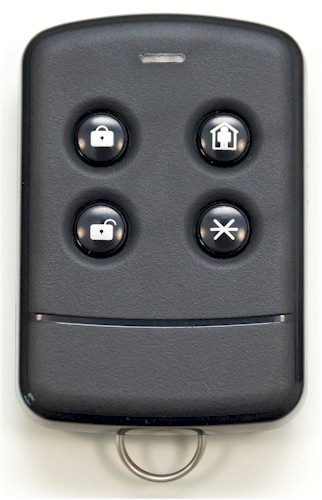
Securifi Key Fob
Flood Sensor (SZ-WTD01)– I can really see the value of this sensor. I’ve had a blocked air conditioner condensation line back up and flood my downstairs neighbor. The flood detector is designed for instances like that, or for burst hot water heaters. Like the Motion and Door/Window sensors, the Flood sensor has a spring-loaded tamper switch that is tripped when the case is opened. It uses a pair of CR2032 batteries and has an average battery life of 2 years. You can mount the sensor with screws and bracket.
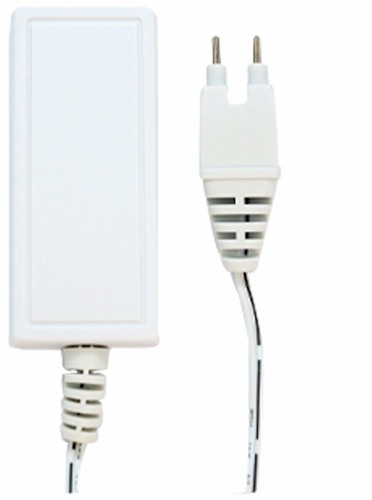
Securifi Flood sensor
The probe is held in place with a bracket you screw to the wall. The prongs of the sensor are pointed down towards the floor (or catch basin) so that they can detect water. To test the flood sensor, I used a glass of water. I dipped the tips of the probe into the water ~ 1/4″, and the sensor immediately switched to flood mode. When I removed the probes from the glass, the sensor status went back to OK.
Each of the sensors in the gallery above has a “Notify me” option revealed when you click on the wrench icon located to the right of the sensor image. You choices are Off, Away and Always. If you configure Notify me for “Away”, you only receive in-app notifications when your status is set to “Away”. The “Always” option will create an in-app notification every time the sensor changes status.
You can only configure the “Notify me” options in the Android app. The “Notify me” configuration options don’t appear in the iOS app, nor do in-app notifications work on iOS devices. You can, however control the sensors and rename them and change their location tags from within the iOS app.
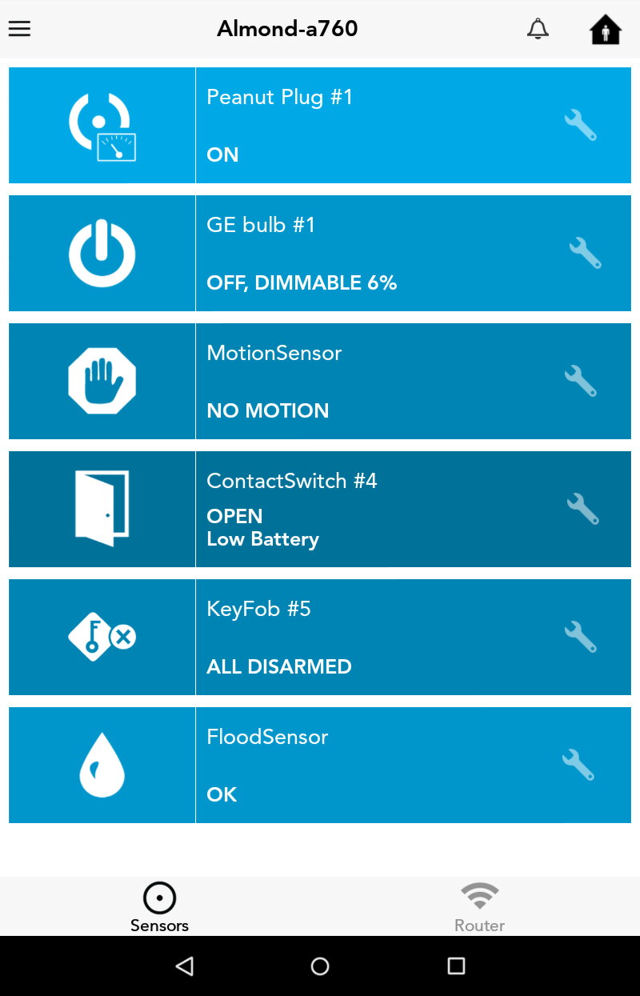
This shows all installed sensors on a Nexus 7
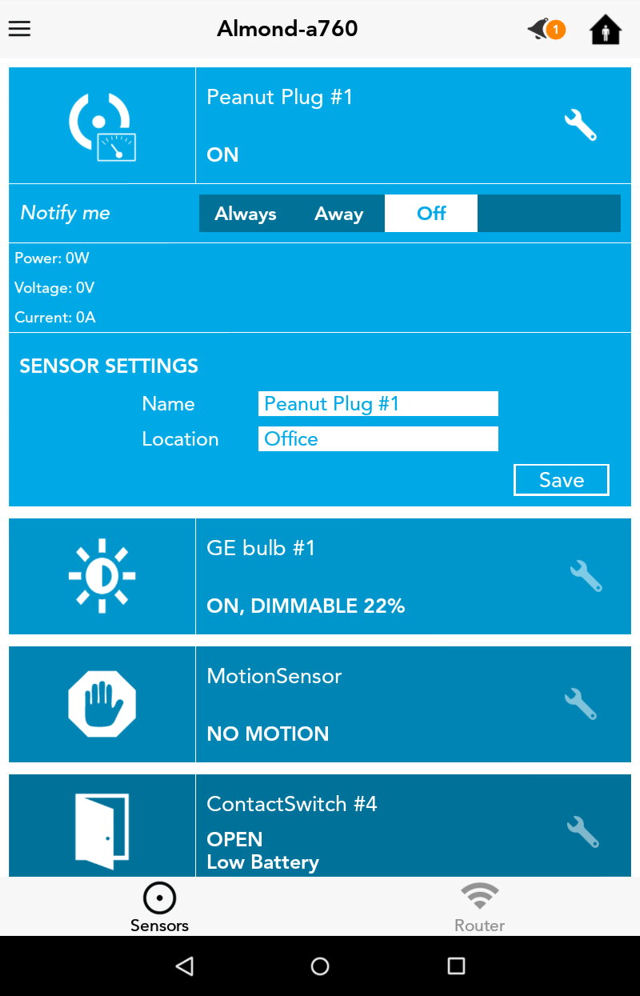
Notify options plus Sensor Settings
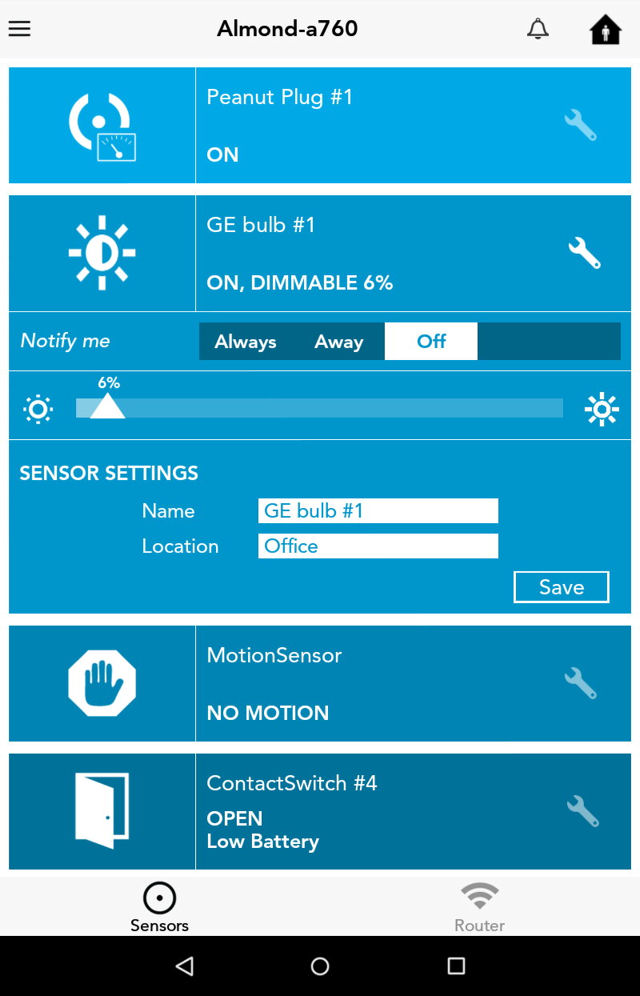
On/Off, dimmer settings, notify options plus Sensor Settings
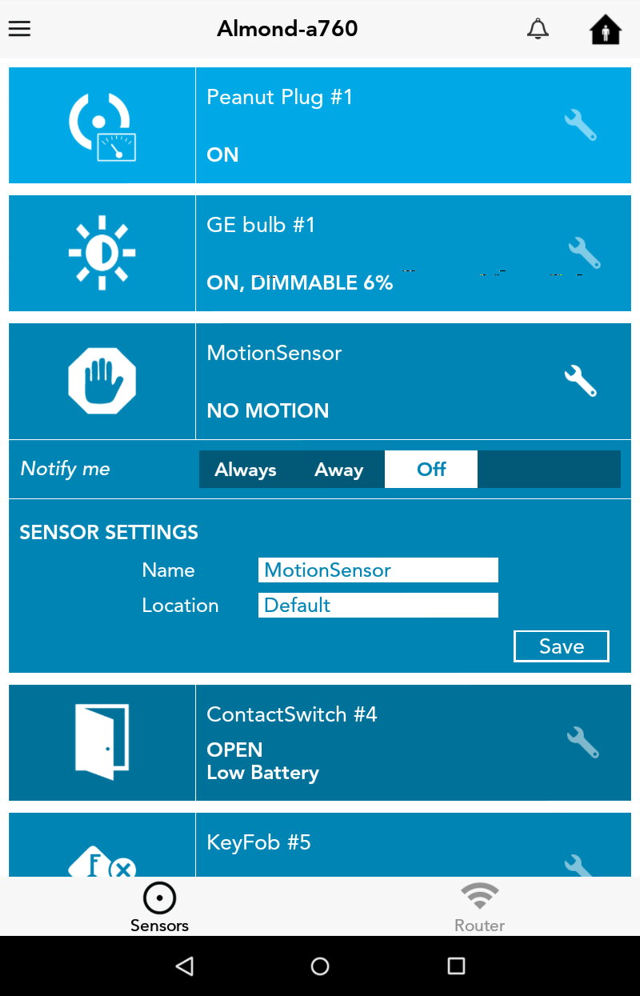
Notify options plus Sensor Settings
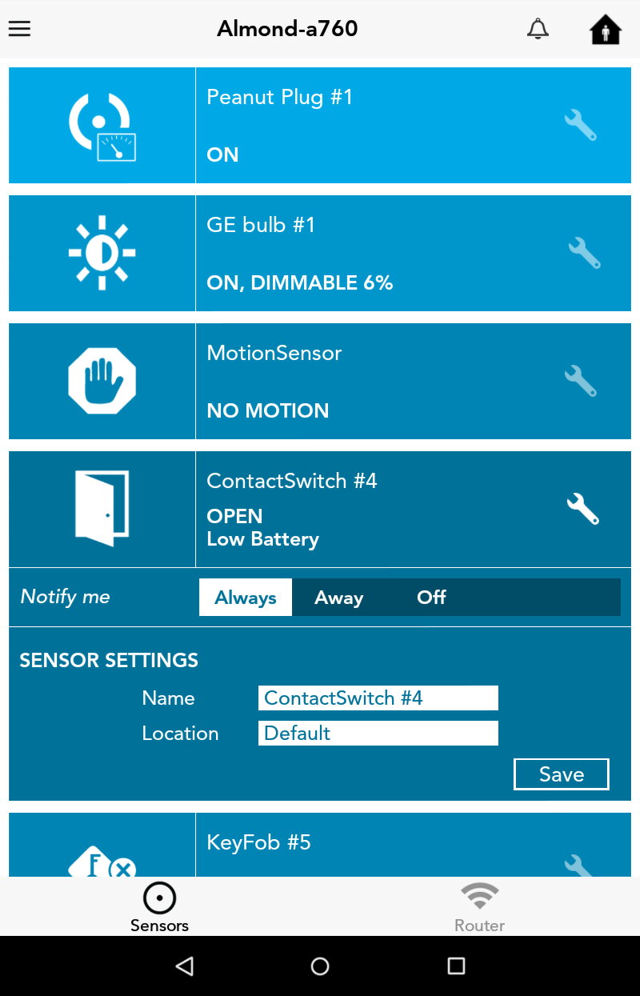
Notify options plus Sensor Settings
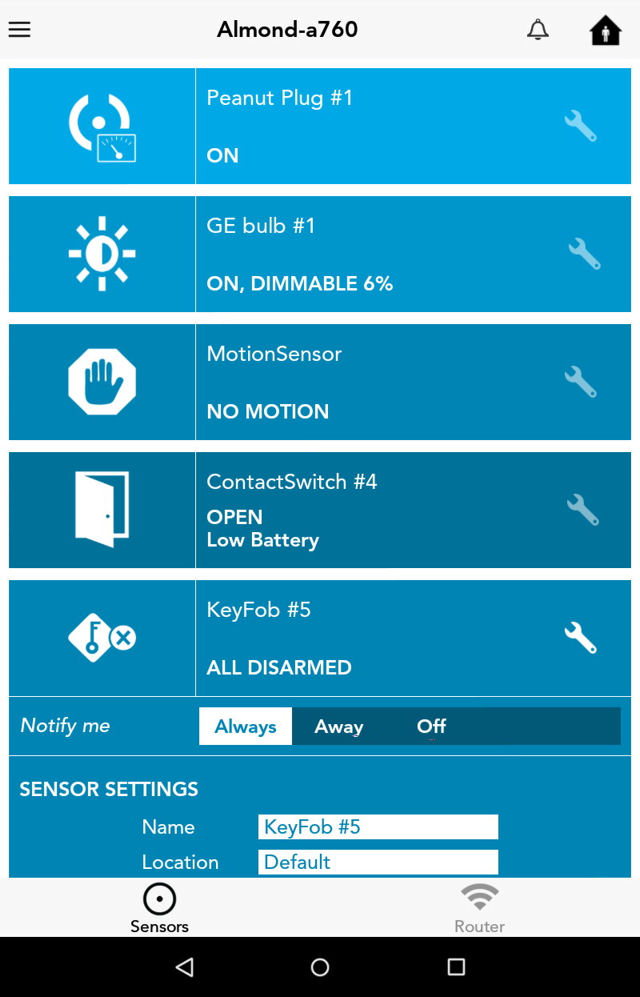
Notify options plus Sensor Settings
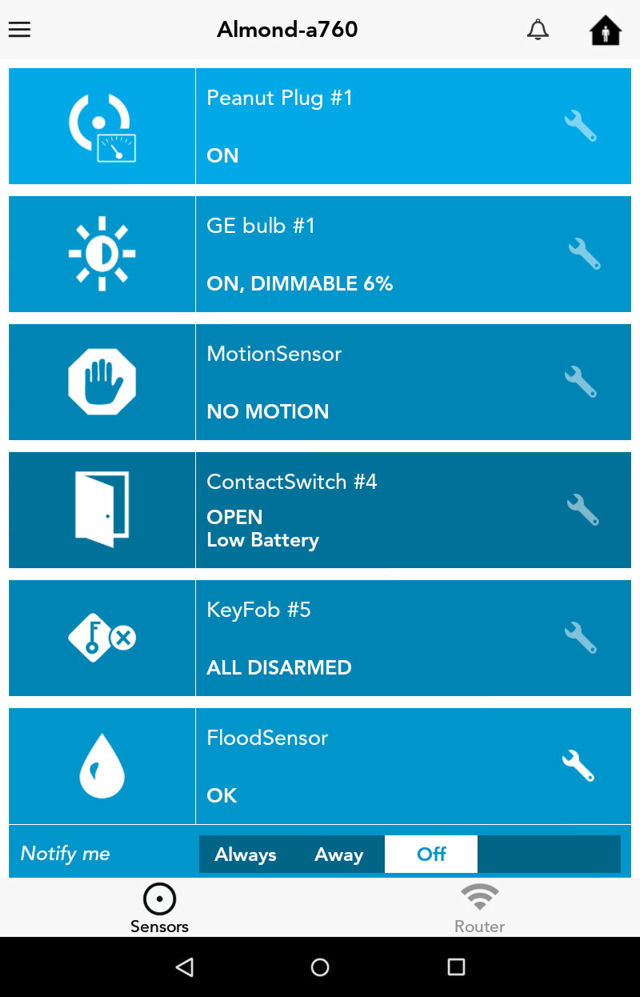
Notify options plus Sensor Settings
Closing Thoughts
Installing and configuring the six ZigBee devices was really quite easy. But I was disappointed there wasn’t a consistent user interface among the web browser interface and Android and iOS apps. You can only create rules using the web browser, and then only with a local connection. You can only change notification options using the Android app.
In my tests, I found the Android app, both on my Samsung S5 and Nexus 7, appeared to be stable. Response time, as reported by the Web UI, was very quick. However the iOS app was a disappointment. Without notifications in the iOS app, a significant number of potential customers are being left behind. I also found that that iPad app seemed unstable. I had the app hang multiple times and ended up re-installing it three times.
For home automation systems, control is only half the formula. Without adequate notifications, you’re missing a key component of home automation. While the in-app notifications for the Android platform seemed to work well enough, there aren’t any options for email or text messaging. On the Android platform, you can only scroll the notification log. There’s no provision to export the log, filter the log based on sensor, date, etc., or to even clear the log.
Some manufacturers like Belkin have passed off some of the “heavy lifting” of notification to third parties such as If This Then That. For example, every time a WeMo motion sensor trips, an entry can be made in a Google Spreadsheet – all via a script donated by an IFTTT user. But when I tried this, I was receiving text messages whenever the WeMo motion sensor tripped during normal working hours and ended up disabling the feature.
In my discussions with Securifi, they said there aren’t current plans for text messaging, email or integration with IFTTT. However, they allowed if there were enough customer demand for particular features, they would consider adding them.
As of today, I’d say the Almond+ home automation features have “good bones”. The basic infrastructure seems to be in place and the ZigBee sensors were easy to set up and were reliable in my testing. (Note, I did not test Z-Wave support in the product.) But the applications, especially on the iOS side, need work and possibly some more enhanced notification features.
Bottom line is the Almond+ and its ZigBee sensors are easy to set up and use. But features, including notifications, are basic and are stronger on Android than iOS. It’s questionable whether Securifi has the resources or desire to become a major player in the Smart Home / Home Automation market. The company’s main focus is easy-to-use touchscreen-based routers. The Almond+’ HA features seem more like a way to differentiate the router and sell more of them, not a way to extend Securifi’s product lines.
